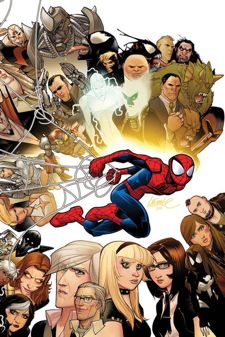Welcome to Wednesday Comics Pull-List, here on Tor.com! Every week we post reviews of a select handful of this week’s comic releases. From those reviews, we let you know what we would pull for keeps.
This week’s batch includes:
- Batwoman #0
- Conan the Crimmerian #25
- Detective Comics #871
- Kull: The Hate Witch #1
- The Terminator: 1984 #3 (of 3)
- Utimate Comics Spider-Man #150
- The Walking Dead #79
Annie has a really good week with Batman and The Walking Dead, while Matt finds something very askew about Batwoman. Both he and Chris find themselves thrown from the Ultimate Comics Spider-Man train, even though they enjoyed reading it! (Conan and Kull are…different matters.)
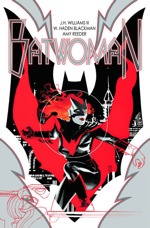 Batwoman #0
Batwoman #0
Written by J.H. Williams III & W. Haden Blackman
Art by J.H. Williams III & Amy Reeder with Richard Friend
(DC Comics)
Pull: Don’t bother. Makes an interesting subject for feminist critical theory, but what doesn’t? You’re better off watching old Hitchcock movies—and if you want your J.H. Williams fix, pull out those old Promethea trades…!
Matt says: As the numbering here suggests, issue #0 doesn’t really yet put us into the Batwoman series; the issue in fact follows Bruce Wayne as he stalks Batwoman (by night) and Kate Kane (by day), in order to determine whether they are, in fact, the same person (spoiler: they are). What’s interesting to me is that Williams and company have decided to launch (or at least preview) a new female-centered superhero book by illustrating the male gaze. Narrated by Bruce, the issue keeps Kane/Batwoman at a distance—she is an object viewed, and not yet the subject of her own book. The issue thus ends up as a strange sort of performative contradiction. On the one hand, we have a female superhero with a less sexually-objectifying costume than most (nipples on the cover notwithstanding…), and Kate Kane is likewise dressed and handled with the dignity all too often reserved for male characters. But on the other hand, the plot carrying us through this issue is that Bruce is watching Kate from a distance, deciding whether or not she’s worthy. He sees her, while she does not see him. He judges her, as she carries on about her business. We follow the book through his perspective, watching and judging her from afar. Kate is thus made powerful and dignified with one hand (her costume; her martial arts skills and ability to handle herself; her passing the test and “deserving” her own book), while this power and dignity is taken away with the other (her objectification through distance; the “licensing” of her power by the male authority). As a psychological phenomenon, it’s fascinating; as if, in the male dominated world of comic book superheroes, a strong female character can only be introduced by framing the book in such a way as to make her “safe” for the male audience. Laura Mulvey would probably say that it’s a way to assuage the castration complex; that is, if Mulvey ever read comic books…
But if Batwoman #0 is fascinating from a psychoanalytic and culture-critical standpoint, alas it is not as fascinating from a comic reader’s perspective. In keeping Kane at a safe distance, Williams and Blackman also fail to make her an interesting character, the sort we might want to read a whole series about. If—as I suspect—the real reason for putting out a “zero issue” is to hype the ongoing series (beginning in February), then it seems to me that the zero issue should make the soon-to-be protagonist as interesting and fresh as possible. By making her Batman’s object rather than her own subject, Williams and Blackman end up giving us simply one more Batman detective story; if there’s a character in this story to be identified with, cheered for, or commented upon, it’s Batman himself. Why, then, would someone who liked this issue pick up the first issue of Batwoman? Why would (s)he not simply wander down the aisle to one of the million Batman titles already available?
Of course, I suspect that the answer to that question—for those able to offer such an answer—is going to involve J.H. Williams’s artwork. And certainly, any time Williams draws a comic, it’s worth checking out; though in this case, I should also like to point out that Amy Reeder deftly handles the other half of the art chores, and is quickly becoming an artist to watch. But if the new Batwoman series offers us a monthly chance to see Williams’s artwork, it thus far doesn’t look like it will be doing much else. Judging from the 16-page preview of the series, it’s simply offering us the same old Bat-stories, albeit in a red wig.
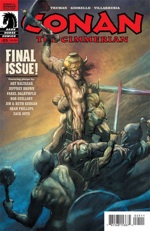 Conan the Crimmerian #25
Conan the Crimmerian #25
Written by Tim Truman
Art by Tomas Giorello
(Dark Horse)
Pull: If you’re already reading the title then you’re getting this, although it does say something about how fun the issues preceding it have probably been.
Chris says: This issue made me a giggle a bit, as I’m new to the Conan comics ouevre, but it’s certainly a title that is true to itself and makes no excuses. Here’s the storyline: On a tropical island, Conan fights a huge ape bent on attacking beautiful outcast Olivia while elsewhere pirates who had formerly imprisoned Conan get eaten by, I think, zombies. That part’s not real clear, though it doesn’t need to be.
It’s a simple tale, told in expressive detail and drenched in blood art (there is a panel where blood gushes from one of the ape’s severed limbs that was particularly…stirring) and it’s a lot of fun for what it is. Conan fights, he loves without brutishness, and sometimes he gets a little whiny about it. Overall he’s having fun, though, and that becomes infectious.
If you’re not a fan of Conan already then this isn’t going to change your mind, but it’s a fun book. The solicit information for this issue promises more Conan from this particular creative team and a take on the warrior as he becomes older and mired in politics. I’m looking forward to that.
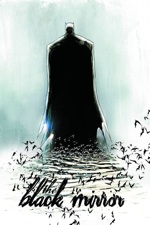 Detective Comics #871
Detective Comics #871
Written by Scott Snyder
Art by Jock, Francesco Francavilla
(DC Comics)
Pull: DUDES. YES.
Annie says: This is the first part of “The Black Mirror,” which I am predicting will be an unbelievable three part storyline.
Meet Dana Redford; a trust fund kid attending an all boy school. The problem with Dana is that he’s being picked on a lot in school, which is where this issue opens up. While in the locker room, Dana is approached by what can only be described a typical bully. He’s shoved into lockers and when he retaliates, the bully pulls one of the classics out and gives Dana a swirly. Except while immersed in toiled water, something happens to Dana. He transforms into a compact version of Killer Croc, bites off the bully’s hand and immediately collapses. This is where the Bat comes in. As it turns out, someone is stealing police evidence and selling it to the highest bidder. Thus far, we’ve seen the same chemical compound used to create Killer Croc but there’s definitely more to come. I don’t want to ruin anything but you can expect to see a reference to Poison Ivy’s compound as well, which leads me to believe that this series is going to feature a profusion of old nemeses. I’ll be honest, Killer Croc is probably one of my favorite villains and the fact that three pages in we get to see him reemerge, even in such a subtle way, was so refreshing.
On top of hinting that more throwback villains would be referenced, we get an insight into Dick Grayson’s existence within Gotham now that he’s been living in Wayne Manor. He’s definitely a different kind of Batman and in this issue it’s appreciated in a big way by Gordon. Dick and Gordon are talking on the rooftop where the Bat Symbol is and when Gordon looks up from turning the light off, he sees that Dick is still there. He looks puzzled, Dick Grayson asks if there’s something wrong and Gordon responds with “No… I supposed I’m just not used to it yet. To you still being there when I look up.” Don’t you just love those tender Bat-moments?
 Kull: The Hate Witch #1
Kull: The Hate Witch #1
Written by David Lapham
Art by Gabriel Guzman
(Dark Horse)
Pull: Fans of Howard’s characters should give this one a try; it’s a decent first issue, and may turn into a series worthy of its name.
Matt says: Though (marginally?) less well-known than his literary successor (and fellow Howard creation) Conan, I’ve always preferred Kull. He is—if you will—sort of a “thinking man’s Conan”; all of the stoic, bad-ass machismo, but with more political intrigue and philosophical introspection. Issue #1 of the new Kull series looks promising on this score, as Lapham and Guzman’s Kull mixes sword swinging and witch hunting with the delicate needs of state politics and courtly responsibilities. That said, we find that Kull (who has, as you’ll recall, risen from gladiator to soldier, soldier to general, and finally general to king in his adopted home of Valusia) tiring of politics, largely leaving the matters of state to his wife (Igraine) and advisors. By the end of the issue, Kull has pursued his enemy to the sea, and it appears that he’ll be setting out solo for his native Atlantis by the next issue. This alone time would give him plenty of opportunity for brooding introspection in a Robert Howard tale—but in the visual-heavy medium of comics, it remains to be seen whether removing Kull from court politics will make him little more than an Atlantean Conan.
In the meantime, Lapham and Guzman have given us an enjoyable first issue. The mysteries surrounding Kull’s connection to the antagonist Heka-La are engaging, and Guzman’s pencil art (with capable inks from Mariano Taibo) is lively and attractive. Lapham doesn’t allow himself to get too bogged down in exposition—indeed, some of the early setup is perhaps handled even a little too briefly—and so the first issue manages to set a nice, brisk pace for the series to follow. It may be too early to tell at this point whether or not Kull: The Hate Witch is going to stand up to its source material. But for a first showing, the signs are good.
 The Terminator: 1984 #3 (of 3)
The Terminator: 1984 #3 (of 3)
Written by Zack Whedon
Art by Andy MacDonald
(Dark Horse)
Pull: If you like Terminator comics, this is still one of the best. If you’ve been picking the series up so far, this will serve as a nice ending. If you haven’t, then stay tuned for the trade collecting both 3-issue story arcs, and make your final decision then…
Matt says: Zack Whedon and Andy MacDonald wrap up their second (and, for the moment at least, final) Terminator story arc this week, with a relatively straightforward ending. The first two issues, you’ll recall, were cleverly woven into the narrative of the first film and its aftermath—so cleverly, in fact, that I was never quite sure whether we were being given a relaunch (and a new status quo) or an artful retcon intended to smooth the gaps between the stories that have already been told. This final issue seems to answer this question, at least: by the end of the book, we seem to have a brand new status quo, providing room for a complete reimagining of the series. That said, nothing here is so final that it could not all be undone; one already sees how simple it would be to weave this “new status quo” directly into the start of the second Cameron film…
The most poignant part of the issue was the ongoing wrap-up to the Ben/Paige storyline, which was more or less finished at the end of the “2029” storyline, but has continued to drag out throughout the “1984” series. On the one hand, this makes “1984” feel like merely an extended denouement; on the other hand, however, it is the psychological character development allowed by this extended wrap-up that really gives the new character Ben his compelling depth and interest. In the end, it seems that Whedon has not so much relaunched the Terminator series with these two story arcs as he has launched a new character within that series. Ben is the real accomplishment, here—and the fun time-paradox and robot-killing story arcs were basically just a vehicle for that accomplishment.
The good side here is that Whedon has done something fresh with the Terminator franchise, by showing that it’s possible to tell compelling stories set in the Terminator-verse that don’t center on John and Sarah Connor (or even Kyle Reese). On the bad side, however, these six issues now feel like backstory, setting up a compelling character who has now run out of space to have adventures in. These two arcs really only pay off if we get the sort of compelling, non-Connor-centered stories promised by his creation. Barring these sorts of stories, the “2029-1984” arc as a whole starts to feel like fan fiction: a new character woven into a series we’ve already read. Ben is all unfulfilled promise right now—kind of like the future itself.
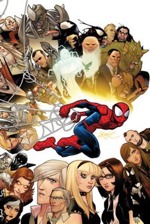 Utimate Comics Spider-Man #150
Utimate Comics Spider-Man #150
Written by Brian Michael Bendis
Art by David Lafuente, Justin Ponsor, Sara Pichelli, Joelle Jones, Sunny Gho & Sakti Yuwono, Jamie McKelvie, Matthew Wilson, Skottie Young, Jean-Francois Beaulieu
(Marvel Comics)
Pull: Yes, but… – Chris
Don’t bother. – Matt
Matt says: Back when the first few issues of Ultimate Spider-Man had just come out, a friend of mine handed me the reprint collecting issues #1-3 and said, “You should buy this. If you read it and don’t like it, I’ll give you your money back.” Needless to say, I never had to ask for a refund, and Brian Bendis’s re-imagining of Spidey for the 21st century has been a favorite ever since. I quickly learned to love Mark Bagley’s art on the book, to the point where his departure was only tolerable because Stuart Immonen—a personal favorite—was his successor. Immonen’s departure after issue #133 was a rough blow, and—though the book (under its new Ultimate Comics Spider-Man title) has kept up the tradition of sharp, fresh artwork—I took a break from the series following the status-quo-shaking events of the “Ultimatum” storyline. The return to the old numbering system for the landmark 150th issue seemed like a fine time to return to the book myself; and I find that, like any good soap opera, the story is remarkably easy to slide back into.
Indeed, I might say that issue #150 felt a little too familiar. When last I left Peter Parker, he had grown from a kid fumbling with newfound powers and responsibilities into a strong, respected hero. Even Jameson was coming around, and the heartfelt “Requiem” storyline was a nice comment on the admiration Peter Parker had earned from his superpowered peers, his friends, and his community. Imagine my surprise, then, to see Peter being treated once again like a wet-behind-the-ears upstart in this anniversary issue. The narrative follows Carol Danvers as she decides what to do about “the Spider-Man issue.” Surely, this is all ground we covered a year or two ago? Danvers seeks the advice of Tony Stark, Steve Rogers, and Thor, who each share their impressions of the new hero. But surely, this sort of “first impressions” business has long since been replaced by the familiarity that comes from countless encounters, crossovers, and team-ups? Reading issue #150, I would almost assume that it was set several years in the past—were it not for Peter’s interactions with Johnny Storm and Bobby Drake, confirming that yes, this is all happening “now.”
[SPOILERS FOLLOW] To Bendis’s credit (and let’s not lose sight of the fact that he’s a hell of a writer—even the worst passages of this book are still delightfully scripted, if not as carefully edited…), the retreading of the status quo seems to be done for the express purpose of shaking that status quo up a bit: Peter’s being sent to superhero school, as Danvers has decided to get some of the Big Guns in the superhero community to mentor Spidey. But did we really need all of the run-of-the-mill Spider-anecdotes to get here? Surely, this decision could have been just as easily set up in a page or two, and we could have jumped straight into the new training. You’ll recall that Bendis has often used the Ultimate Spider-Man annuals as an excuse to tell Peter Parker/Mary-Jane stories, often with a minimum of tights and punch-ups. These anniversary issues—like all of Bendis’s greatest work on Ultimate Spider-Man—worked because they felt fresh, different, and personal. They weren’t mandatory for understanding the ongoing series, but you were glad you picked them up because they fleshed out the characters and their world in a way that helped you further invest in and engage with those characters. Issue #150 has the same sort of non-mandatory-reading feel to it—but for the first time, I don’t feel like I’ve gotten a story that I’m glad to have dropped an extra couple of bucks on. Both the main feature and the backup feel less like character development, and more like an opportunity to show off a variety of artists.
With that said, the high point of the issue is the art. Ongoing USM artists Lafuente and Pichelli both turn in great performances, and the worst-written segment is saved by great art by Skottie Young. The backup feature—a rather long-winded tale about the early Ultimate Spidey figuring out what it takes to be a hero—is a veritable who’s-who of comic artists, from Alex Maleev, John Romita, Sr., and Frank Cho, to Jim Mahfood, Craig Thompson, and James Kochalka! It’s an impressive line-up of talent, though (for that reason?) it reads more like a tribute to Ultimate Spider-Man than an Ultimate Spidey story in its own right. In the end, this is perhaps what you could say about the book as a whole: it gets too caught up in marking the milestone, and pays too little attention to the sort of fresh, innovative quality that brought the series here in the first place.
Chris says: I jumped on this title about 110 issues ago and eagerly gobbled up the trade collections before me. This title lends itself extraordinarily well to collections. Writer Brian Michael Bendis’s decompressed method of storytelling tends to add up to a lot when taken in a 6 to 10 issue gulp, so you feel like you’ve just experienced a momentous moment in Ultimate Spidey’s life.
Lately, however, I’ve been taking this title on an issue by issue basis, and that same decompression makes for awfully light reading. The book has also seemed fairly directionless since being forced to reboot after Marvel’s ill-conceived “Ultimatum” event. I love how much the cast has expanded since then, but that same decompressed storytelling style rears its head here, too, as it feels like Bendis isn’t doing as much as he could with these characters.
Ultimate Comics Spider-Man #150 addresses a lot of these issues, serving as a complete standalone story and providing a good jump-on point for new readers. I’m also excited by Sara Pichelli’s art, which we get a sneak peek of in this issue, as it heralds a welcome return to the more character-based storytelling styles of Mark Bagley and Stuart Immonen. The story in the issue is good, too, and finally answers a long-lingering question the title has batted around since its inception, one that is unique to the Ultimate version of Spider-Man. But…
But I’m starting to feel that same malaise that one feels after several seasons of their favorite show. It’s a common criticism you see ascribed to The Simpsons. You know it’s still a quality program but it’s no longer a priority, or you’re too used to its humor, or it doesn’t have anything new to tell you about its characters, etc.
In comics, this would call for a shake-up of the title (A new direction! Costume! Etc.!) but in the case of Ultimate Comics Spider-Man that would be entirely the wrong direction to take. If anything, the title needs to recapture the urgency, focus, and creativity of its earlier issues. Ultimate Comics Spider-Man #150 is a step in that direction, and a good comics on its own, but I’m taking a wait and see approach to ensuing issues.
 The Walking Dead #79
The Walking Dead #79
Written by Robert Kirkman
Art by Charlie Adlard & Cliff Rathburn
(Image Comics)
Pull: Yep.
Annie says: In issue #78, the Community was confronted by a gang that wanted to take over but Rick stepped in and managed to save the day without any casualties. This resulted in Douglas stepping down as leader and nominating Rick to be in charge. Everything was pretty kosher until a swarm of zombies showed up as a result of all of the gunfire and that’s where issue #79 picks up.
In this particular issue, the relationships between individual members of the Community were put in the spotlight. It was really interesting to go from watching the Community work as a group in prior issues to examining the dynamics of individual relationships in this one. We start off with Rick and Andrea. Their conversation about how it feels good to be scared is something that I think really opens up the discussion for what these people have been through. They look forward to being able to feel normal emotions and that, to me, is endearing. You want these people to survive because, let’s be honest, they’ve earned it. Aaron and Eric return from scouting with one less horse and a stab wound. Again, the normalcy of their relationship and how they balance each other is put in the forefront. Aaron, in this instance, is a loose cannon and Eric is the calm secure and reassuring half of their relationship.
Later in the issue, Aaron approaches Douglas to tell him that he’s done scouting for new Community members and that they should have no issue surviving with the people they have now. This conversation was actually my favorite part of this issue because of the way it was laid out. At the same time that Aaron and Douglas are talking about not recruiting anymore people, a group outside the gates is trying to rid themselves of a massive group of zombies. The panels alternate back and forth between the conversation with Aaron and Douglass and the people outside and it’s done in such a way that amplifies the tension and gives the reader a hint at the much bigger problem encompassing the group.
Chris Greenland has realized there are two kinds of Conans in this world, those can slice off an ape’s arm, and those who can’t.
Annie Gala over runneth with hundreds, dummy
When Matt Lampert isn’t writing about comics, he’s a philosophy professor in New York City.










